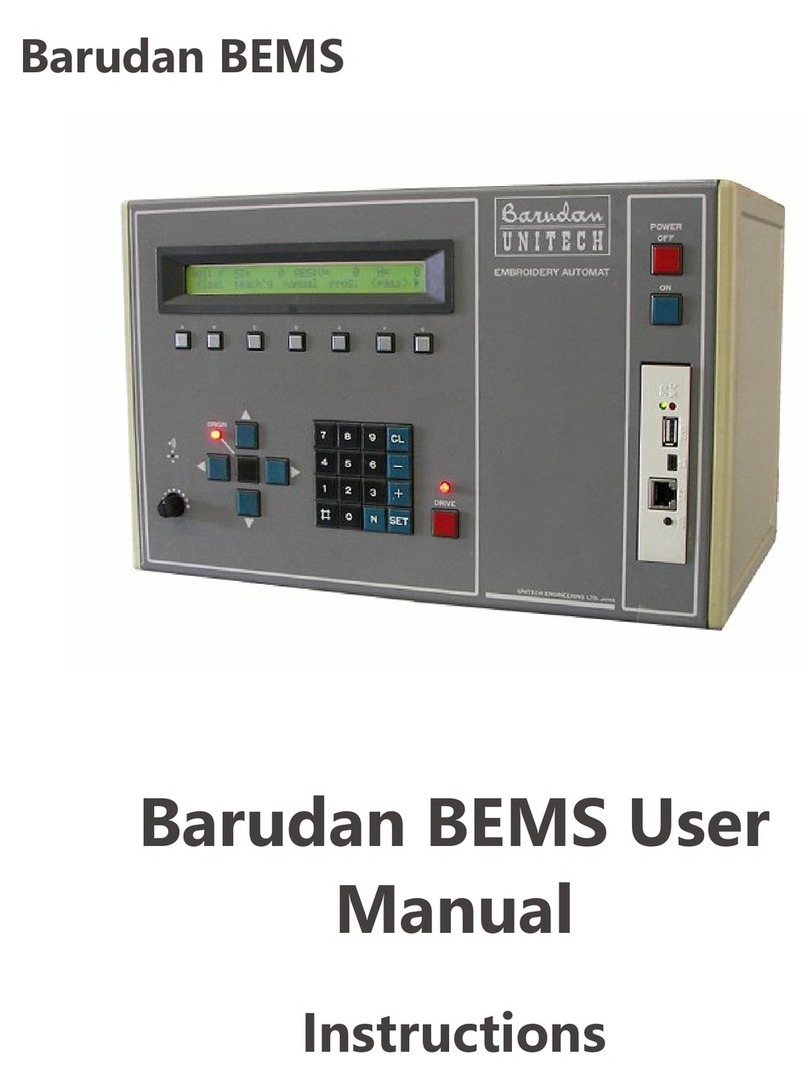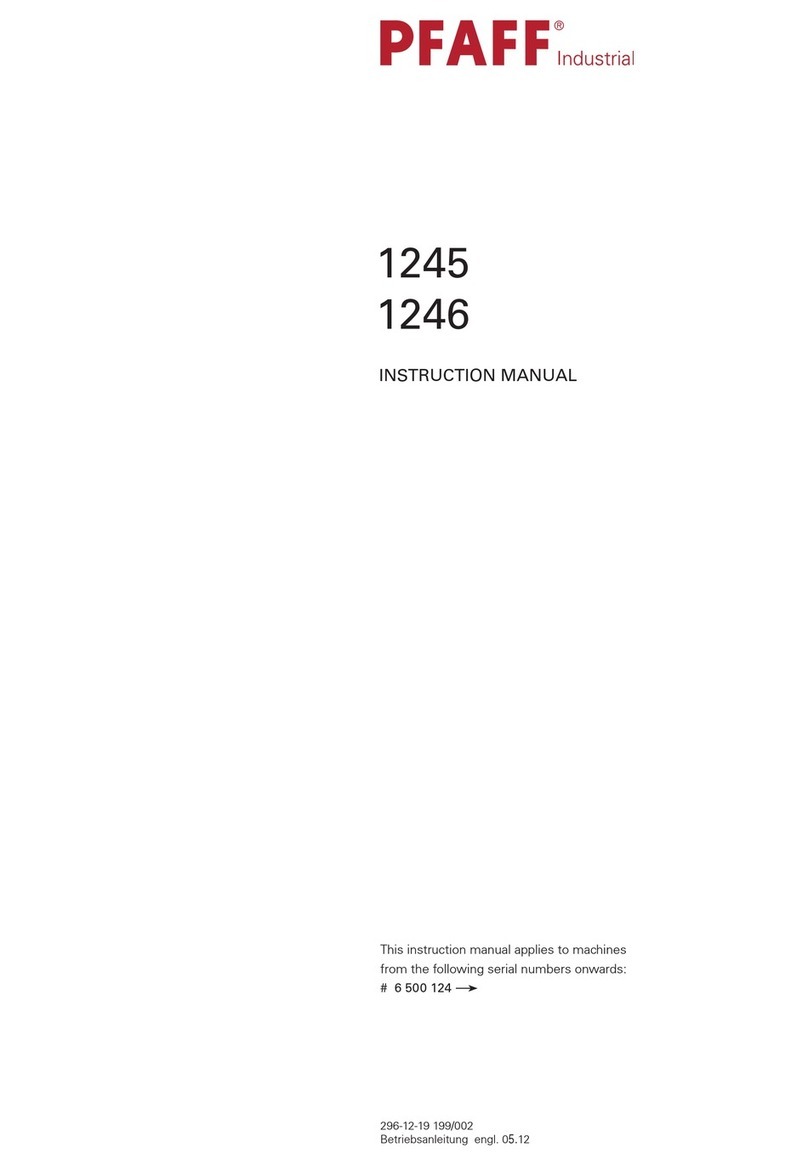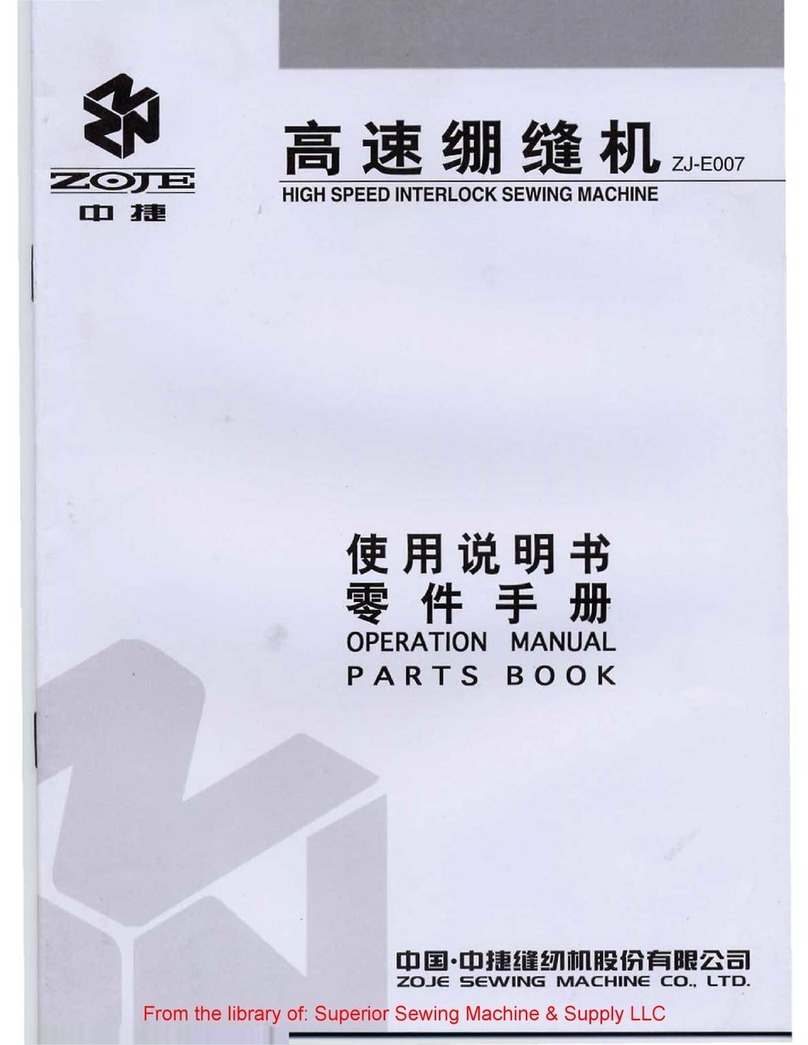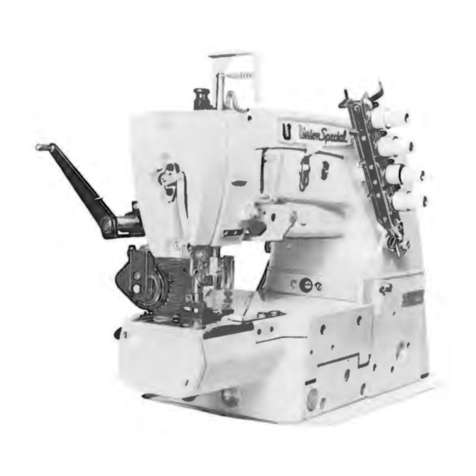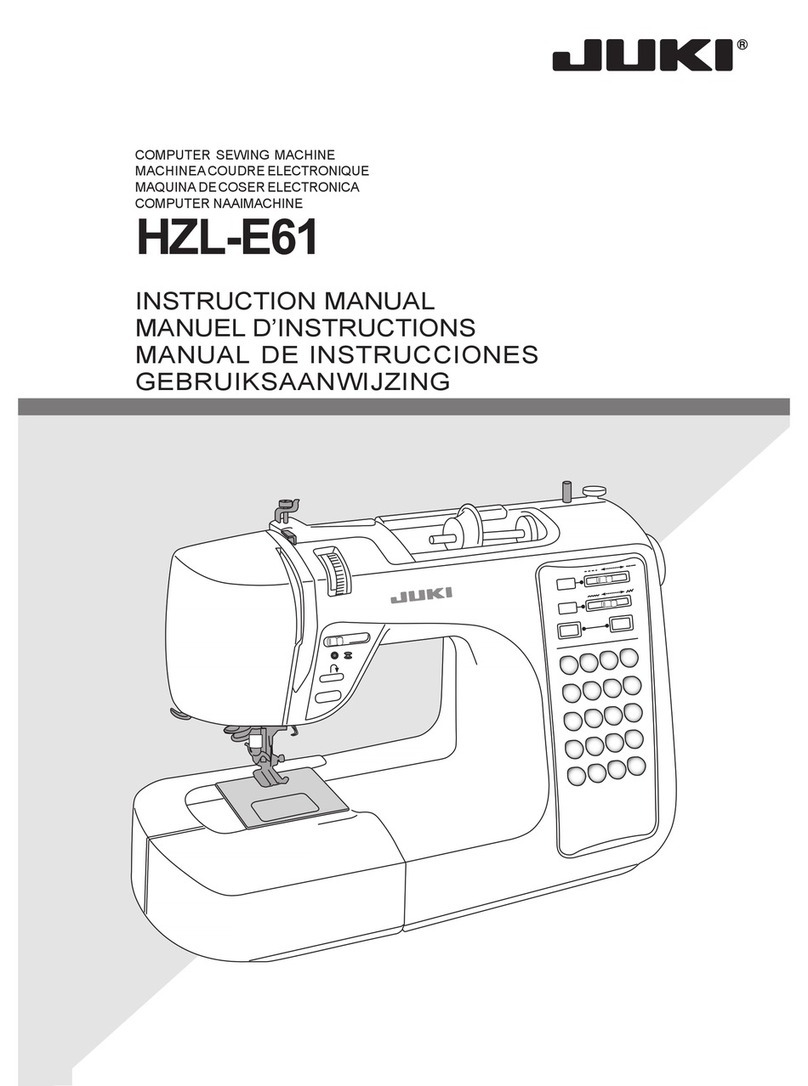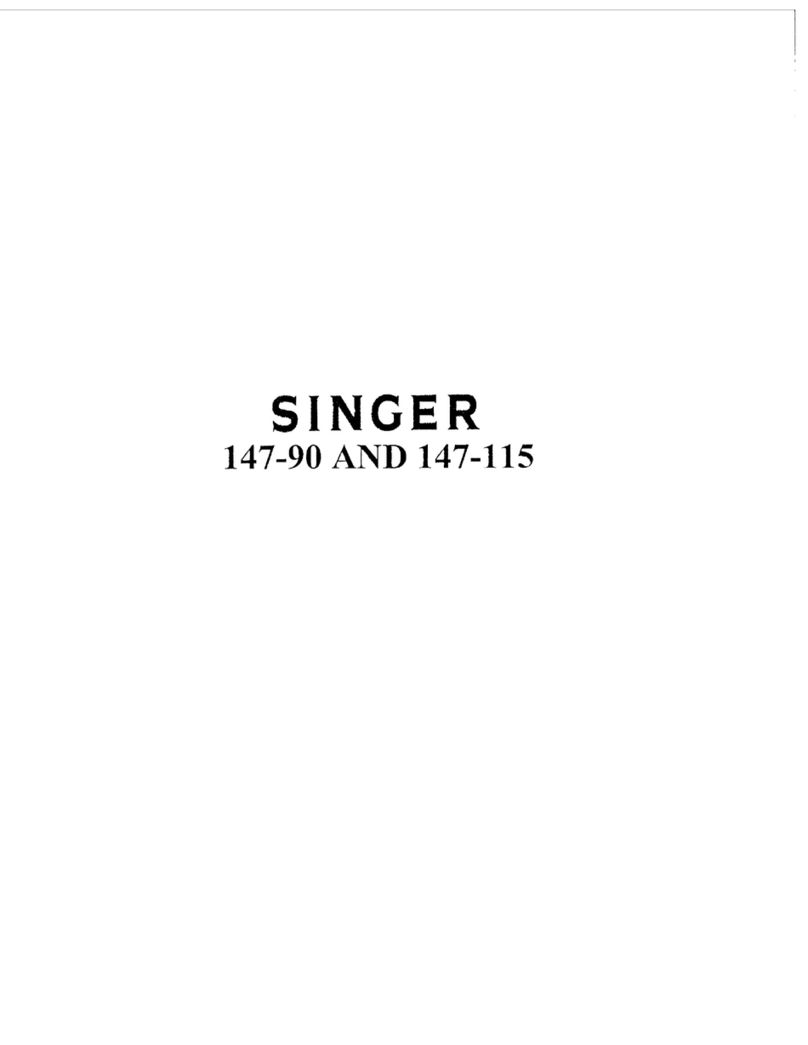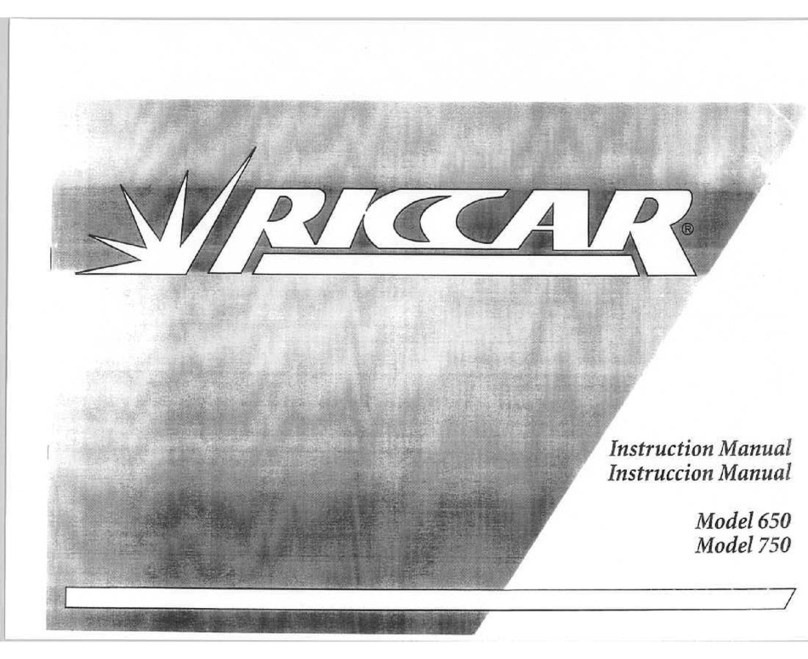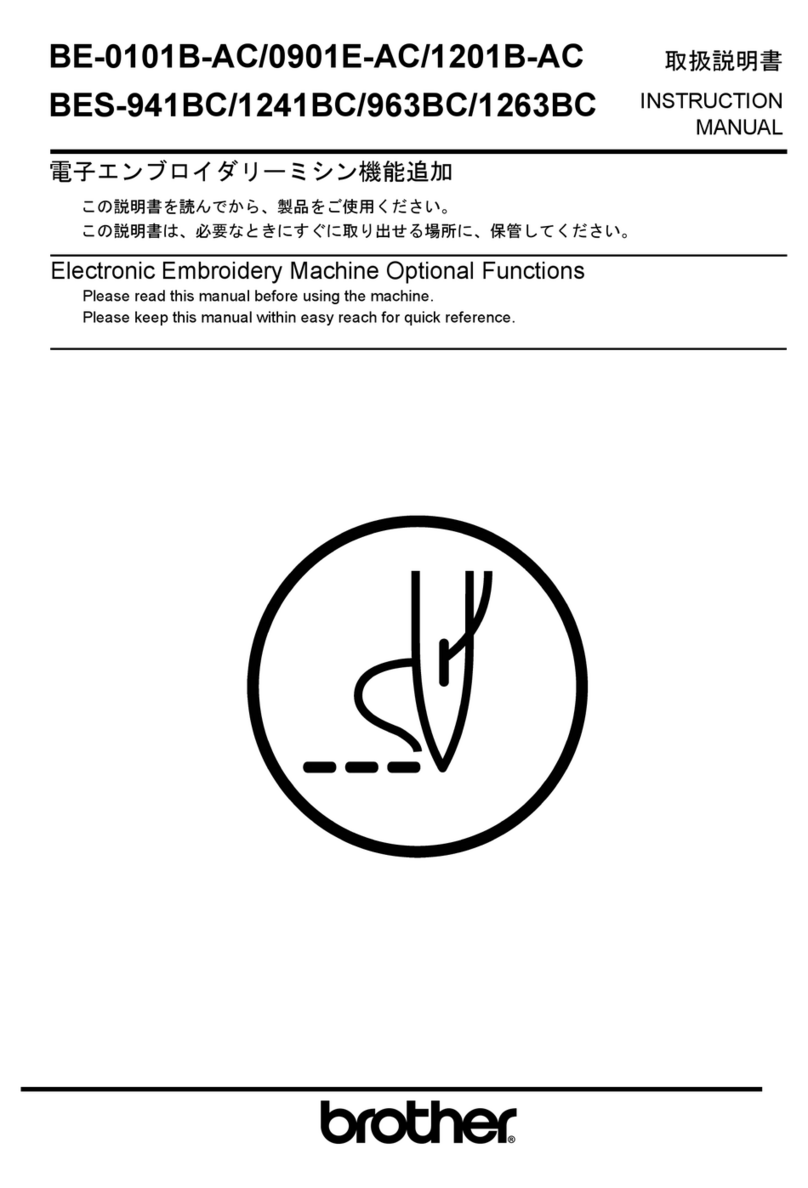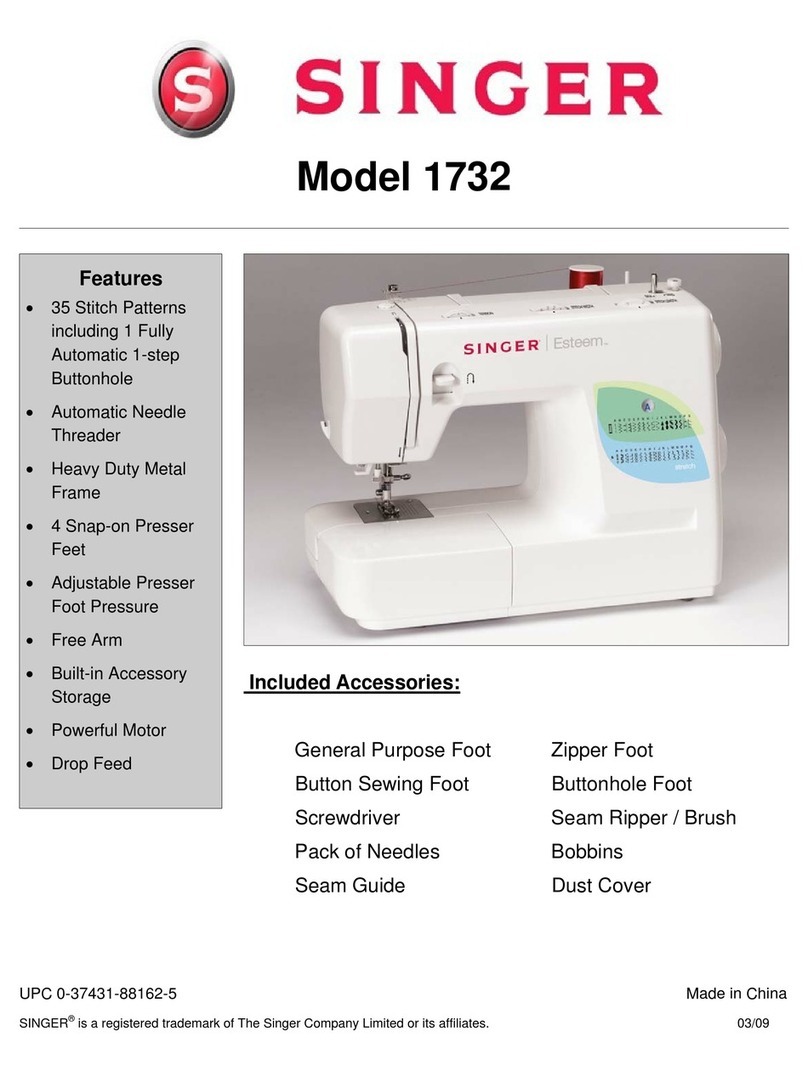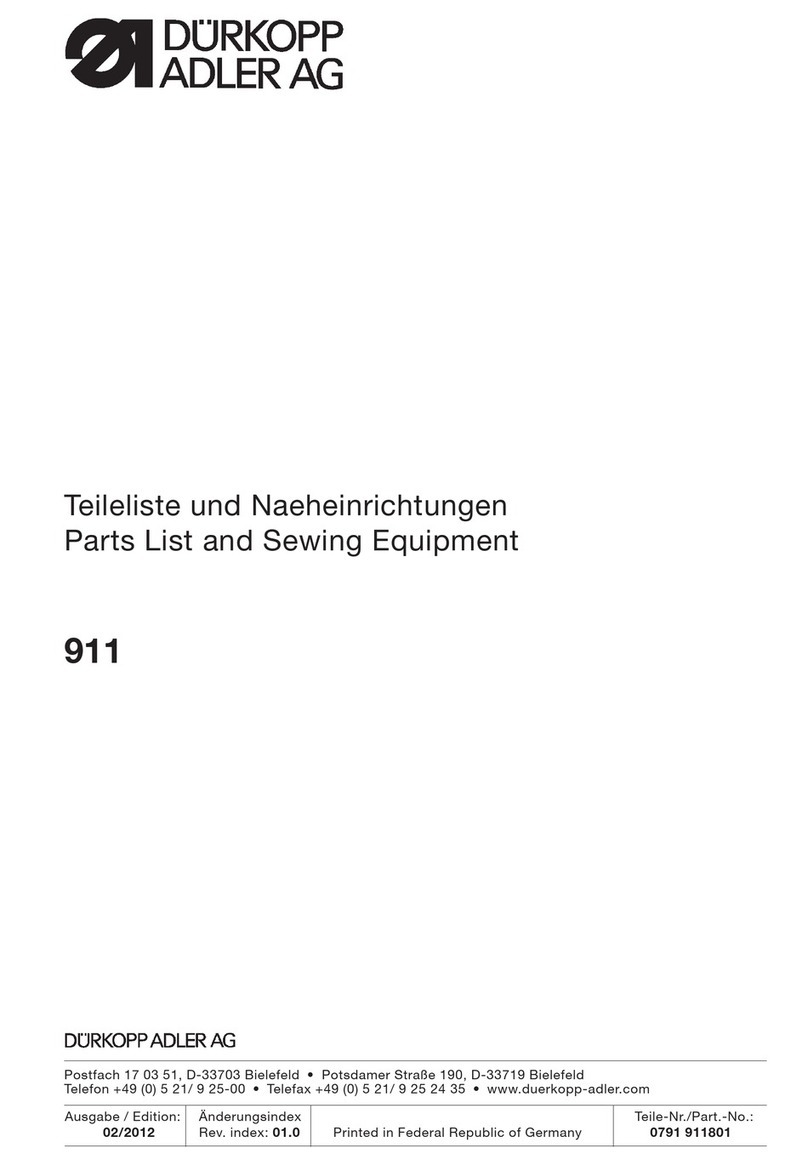KONWA KW-505 User manual

KONWA®
KW-505
DOMESTIC SEWING MACHINE
INSTRUCTION MANUAL
&
PARTS LIST

INTRODUCTION
“KONWA” household sewing machine Model: KW-505 is suitable for sewing all types
of thick or thin materials and for embroidering function too. In addition to using foot
power, the machine may be operated by installing an optional electric motor of which
could be purchased from us separately.
This sewing machine is equipped with a reverse feeding mechanism that allows the
operator to seal the stitches without the hassle of reversing the material. Furthermore, this
machine is also furnished with an adjustable drop feed mechanism. This gives the user
the option to regulate the drop feed low or high when sewing thick or thin materials.
The “KONWA” Model: KW-505 is also fitted with thread take up cam and oscillating
shuttle hook, by which the under and upper thread are locked to form excellent stitches.
“KONWA” household sewing machine Model: KW-505 is assembled by a combination
of over 100 superior quality parts which ensure smooth operation if handled and
maintained correctly by the user. Therefore, the following manual will serve as a guide
for proper usage and maintenance of the machine.

1. THREADING
A new sewer is apt to run the balance wheel in a reverse direction, thus rendering the
thread hitched in the shuttle race or breaking the thread, so it is necessary to practice idle
running. This is carried out as follows.
Loosen the stop motion screw (Fig. 1), so as to turn merely the balance wheel. Then place
both feet upon the treadle, with the left foot a bit ahead of the right, while keeping them
eight or nine cm apart from each other (Fig. 2). Turn the balance wheel towards you
continuously until it gathers speed and you can run the balance wheel on and on always
in the same direction. Thereafter you can tighten the stop motion screw and commence
sewing.
Fig. 1 Fig. 2
2. WINDING THE BOBBIN
Loosen the stop motion screw. Fix a reel of thread onto the spool pin on the machine bed.
After that pass the free end of thread through the tension disc (Fig. 3-1) and then pass it
through one of the holes of the bobbin. Press the bobbin onto the winder spindle, taking
care to see that the small pin in the spindle engages the notch in the right disc of the
bobbin. Then press down the winder-adjusting latch (Fig. 3-3), the bobbin winder latch
(Fig. 3-4) will drop at the same time upon the bobbin and the rubber pulley drops as well
and keeps in close with the hub of the balance wheel. After that with the tight hand turns
the balance wheel towards you and continues to turn the wheel with the assistance of
treading, the thread is thereby wound upon the bobbin. When it is fully wound, the
bobbin winder latch will skip off automatically. Take down the bobbin and retighten the
stop motion screw.
Fig. 3

3. REMOVING BOBBIN CASE
Turn the balance wheel towards you until the needle bar is raised to its highest (Fig. 4-1).
Then draws the bed slide open (Fig. 4-2) and pull out the latch lid of the bobbin case with
the thumb and the fore finger of the left hand (Fig. 5-1) and take out the bobbin case.
Fig. 4 Fig. 5
4. REPLACING BOBBIN
Insert the fully wound bobbin into the bobbin case (Fig. 6). Allow the free end of thread t
pass through the slot and under the tension spring leaf until it enters into the delivery eye.
Leaving the end of thread about 7cm, to hang free (Fig. 8)
Fig. 6 Fig. 7 Fig. 8
5. REPLACING BOBBIN CASE INTO THE SHUTTLE RACE
Turn the balance wheel towards you until the needle bar is raised to its highest. Draw
opens the slid. Hold up the bobbin case by the latch, place it onto the center stud of the
shuttle (Fig. 9-1), allowing the position finger of the bobbin case to set into the notch at
the top of the shuttle race as shown in Fig. 9-2.
Fig. 9

6. CHANGING NEEDLE
Turn the balance wheel towards you until the needle bar is raised to its highest. Loosen
the needle clamp screw, take off the old needle (Fig. 10), and insert a new one into the
needle clamp (Fig. 11) as far as it touches the screw, with its flat side facing the balance
wheel, then tighten the needle clamp screw.
Fig. 10 Fig. 11
7. UPPER THREADING
Turn the balance wheel towards you until the needle bar is raised to its highest. Place a
real of thread on the spool pin on the machine arm. Pass the end of thread into the notch
at right top of the faceplate (Fig. 12-1), down and through the tension disc (Fig. 12-2),
and fender level (Fig. 12-3) from back to front into the loop of the thread take-up spring
(Fig. 12-4), up from back to front through the hole of the take-up lever (Fig. 12-5), down
through the face plate guide (Fig. 12-6), needle bar thread guide (Fig. 12-7). Finally from
left to right through the needle eye, leaving an end of thread about 7cm for catching
bobbin thread.
Fig. 12

8. CATCHING BOBBIN THREAD
Hold the end of the upper thread with the left hand, and with your right hand turn gently
the balance wheel towards you till the needle comes down and up again to its highest
position. Pull the end of the thread in your left hand gently, and it will bring up the
bobbin thread (Fig. 13). Then lay the ends of both then threads under the presser foot but
a bit away from you (Fig. 14). Place the material under it and lower the presser foot,
thereafter start sewing.
Fig. 13 Fig. 14
9. REGULATING TENSION OF THE UPPER AND LOWER THREADS
If the tension of the both upper and lower threads is normal the result will be perfect and
the two threads will cross each other just inside the sewing material (Fig. 15)
Fig. 15 Fig. 16 Fig. 17
But if the upper thread is too tight or the lower one too loose, they will cross each other
on the upper surface of the fabric (Fig. 16). In this case, you should either loosen the
upper thread or tighten the lower one.
If the upper thread is too loose or the lower one too tense, so that they cross one another
on the under side of the fabric (Fig. 17), you will have to tighten the upper thread or loose
the lower one.
Sometimes although the threads are locked inside the fabric, floating stitches appear, that
means both the upper and lower threads are too loose. For correcting this, both upper and
lower threads should be tightened.
Sometimes although the cross point is right inside the sewing material, the material may
wrinkle and the thread is liable to break; for the upper and lower threads are still too tight.
So it is necessary to loosen them both.

To regulate tension of the upper thread :-
Turn the tension disc screw (Fig. 18) indicated by the arrow, and the thread will become
tight; turn it in the opposite direction, and it will become loose.
To regulate tension of the bobbin thread :-
Take out the bobbin case and turn the shuttle tension regulating screw (Fig. 19) in the
direction indicated by the arrow, and the tension of the bobbin thread will become tight;
turn it in the opposite direction, and it will become loose.
Fig.18-1 Fig. 18-2 Fig. 19
10. REGULATING STITCH LENGTH
For thick material, longer stitches are required. While for thin material, shorter ones, the
numbers shown on the stitch indicator represent the different lengths of stitches. The
larger the number, the longer the stitches; the smaller the number, the shorter the stitches.
Fig. 20
The stitch regulator of Model: KW-505 has also the function of reverse feeding that
enables you to seal stitches without the trouble of reversing the material. When you want
to seal stitches during sewing, just move the stitch shifter (Fig. 20-1) over the median line,
then the direction of the drop feed can be changed. Regulating stitch length is a very
simple process. Loosen the stitch regulating plate screw (Fig. 20-2) and lower it to the
bottom. Then move the stitch shifter to the required stitch length, and raise the stitch
regulating plate screw so that it carries the stitch regulating plate (Fig. 23-3) to meet the
stitch shifter. Now retighten the stitch regulating plate screw, and the stitches will be just
as ling as desired. Just by moving the stitch shifter up and to the top and down to the
bottom, the same stitch length can be obtained in sewing in both directions.

11. REGULATING PRESSURE ON PRESSER FOOT
In order to effect smooth feeding of the drop feed, it is necessary to increase or decrease
the pressure of the presser foot according to the thickness or thinness of the materials. It
is advisable to use a button type regulator.
For sewing thick material, press downs the sleeve of the regulator (Fig. 21-1) to increase
the pressure. For sewing thin material, press downs the screw sleeve of the regulator (Fig.
21-2) instead to decrease the pressure.
For Model: KW-505, regulate the pressure according to Fig. 22. To increase the pressure,
turn the pressure adjusting screw in the direction of arrow A and to decrease in the
direction of arrow B.
Fig. 21 Fig. 22
12. ADJUSTING THE FEED DOG HEIGHT
The height of the feed dog is adjusted by switching the drop feed knob. When the thin
fabric being sewn, the feed dog should be set lower. Turn the knob counter clockwise in
order to decrease the height and clockwise to increase the height (Fig. 23).
Fig. 23
13. EMBROIDERING
(1) Change the needle for one of No.9-11.
(2) Move the stitch shifter to the median line on the stitch indicator.
(3) Pull up the presser foot lever, loosen the presser foot screw and take off the presser
foot.
(4) Open the bed slides and fixes the feed cover plate on the needle plate (Fig. 24). Make
sure that the needle is pointing at the hole of the feed cover plate.
(5) After upper threading, put down the presser foot lever and catch the bobbin thread in
the feed cover plate. After the thread take-up lever is raised to its highest, it is not
suitable to leave an end of the upper thread longer than 2cm, for precaution against
hitch of thread in the shuttle race.
(6) Put the fabric to be embroidered into the embroidery frame, fix it tight and even to
avoid wrinkles.

(7) Pull up the presser foot lever to raise the presser bar high enough to allow the
mounted embroidery frame to get onto the feed cover plate. After that, lower the
presser foot lever and commence embroidering (Fig. 25). The speed of shifting the
frame must be coordinated with that of the movement of the needle.
Fig. 24 Fig. 25
14. DISMOUNTING THE BELT
By moving the belt shifter (Fig. 26) to the left and working the treadle, the belt
disengages the treadle wheel by itself. To replace the belt, only put the belt in the right
and turn the treadle wheel in sewing direction, then work the treadle to enable the belt to
cling to the trough clamp at the rim of the treadle wheel. A couple of revolutions of the
treadle-wheel will bring the belt into place.
Fig. 26
15. THE USAGE OF THE HAND ATTACHMENT SET
When a hand attachment is fixed to the sewing machine, it is operated by hand. Being
portable it can be operated on any table. It is best suited for household and traveling use.
Before operation, pull out the crank and fasten its arm (Fig. 27-2) to the fixing pin (Fig.
27-3) made for it. Then push the driving block into one of the spaces of the balance wheel
(Fig. 27-4). Take hold of the crank, turn the wheel smoothly with the right hand in the
direction indicated by the arrow as shown in Fig.27 and start sewing.
Fig. 27

16. CLEANING SHUTTLE RACE
It is necessary to disassemble the shuttle race and take out the shuttle hook for cleaning
after a long time of using. Otherwise the fluff would accumulate there and cause frequent
hitching of the thread.
We have two types of shuttle race, back-open and front-open, which are different in
disassembling.
(1) To disassemble the back-open shuttle race, take off the driving belt, turn up the
machine head, raise the needle bar to its top position, take out the bobbin case, loosen the
shuttle race screws (Fig. 28-1-1) by a screwdriver and you can remove the shuttle race.
Hold the front-face of it with your left hand, take out the shuttle hook from the back-face
of it with your right hand. Be careful that the hook tip should point downwards and the
hook should be lightly pulled out of the center of the circle of the shuttle race.
Fig. 28-1
If the fluff accumulated in the shuttle-retaining ring (Fig. 28-2-1), the ring should be
removed before cleaning. Remove the ring spring (Fig. 28-2-3) by taking out the screw
(Fig. 28-2-2) with a screwdriver. After cleaning, put the ring (bevel face outwards) into
the two pins (Fig. 28-2-4), place the spring on it and retighten the screw. You can
assemble the shuttle hook ad shuttle race by reversing the processes. Making sure that the
guide rail (Fig. 28-2-5) should engage with the guide slot before retightening the shuttle
race screws.
Fig. 28-2
(2) It is very simple to disassemble the front-open shuttle race.
Raise the needle bar to its top position, draw the slide plate open, and take out the bobbin
case. Push aside the left and the right latches (Fig. 28-3-1).

Remove the shuttle-retaining ring (Fig. 28-3-2) and you can take out the shuttle hook (Fig.
28-3-3) from the front-face. After cleaning replace the hook first, and put on the ring. Be
careful that the pin at the side of the ring should engage with the notch (Fig. 28-3-4). Shut
the latches at last.
Fig. 28-3
17. LUBRICATION
For easy and quiet running, the bearings and contacting parts should be kept clean and
lubricated constantly. This will prolong the life of the machine.
For lubrication, sewing machine oil should be used. Never use vegetable oil. One or two
drops for each spot (see Fig. 29, 30, 31, 32, 33) is sufficient. Excessive oiling is not
advisable, as this will stain the material to be sewn.
Fig. 30 Fig. 31 Fig. 32 Fig. 33
Fig. 29
18. CHART SHOWING DIRREFENT SORTS OF NEEDLE AND THREAD FOR
DIFFERENT TYPES OF MATERIAL
Fineness of Thread
Material Needle No. Silk Fabric
Very Thin Muslin Cambric Linen
Embroidery, etc. HA x 1 #9 80 / 3, 70 / 3
80 / 3
Very Fine Calicoes, Linens Shirting, Fine
Silk Goods, Embroidery, etc. HA x 1 #11 80 / 4, 60 / 3
60 / 3
Shirting Sheeting Bleached Calicoes,
Muslin, Silk and General Domestic Goods,
etc.
HA x 1 #14 50 / 3 45 / 3
All kinds of Heavy Calicoes, Light Woolen
Goods and Heavy Silk, Serge, Corduroy. HA x 1 #14 50 / 3, 40 / 3
45 / 3
Ticking, Woolen Goods Thin Canvas,
Trousers, Cloaks, Mantles, etc. HA x 1 #16 40 / 3, 32 / 4

19. LIST OF TROUBLE USUALLY ENCOUNTED AND THEIR POSSIBLE
CAUSES
(1) Breaking of needle :-
a. The needle used being unsuitable for the material or / and the thread.
b. The shuttle back not being well replaced after cleaning of the shuttle race.
c. After changing of needle, the needle being improperly set into the needle clamp or
not being inserted into the uppermost end of the needle clamp. Screw in the
needle clamp not being well tightened.
d. Needle being bent.
e. Presser foot being improperly fastened screw of the adjustable foot press not well
tightened.
f. Moving of the fabric by force while sewing.
(2) Breaking of needle thread (upper thread) :-
a. Wrong process of threading.
b. Needle thread too tense, or poor quality of the thread used.
c. The balance wheel being turned in the wrong direction.
d. The reel of threads being over-fully wound, so that part of the thread being wound
upon the spool pin.
e. Unsuitable needle used for a certain type of material or / and thread.
f. The needle not well inserted or the needle being bent.
g. The shuttle body being damaged by knocking so that the place where the thread
passes is rough.
(3) Breaking of bobbin thread (under thread) :-
a. The hole of the needle plate being rough after the breaking of needle.
b. Thread on the bobbin being loosely wound or over-full.
c. The shuttle race back being damaged by knocking so that the place where the
thread passes is rough.
d. Tension of the bobbin thread being too strong.
(4) Hitting of thread in the shuttle race :-
a. The balance wheel being turned in the wrong direction.
b. The upper and lower thread not being pressed tight under the presser foot.
c. The end of the under thread not yet being picked up or being caught in the latch of
the bobbin case.
(5) Skipping of stitches :-
a. Unsuitable needle used for a certain type of material or / and thread.
b. Needle being bent or its point too blunt.
c. The flat side of the needle facing the wrong direction after being inserted or the
needle not well inserted.
d. The shuttle race back not being well replaced after cleaning of the shuttle race.
e. The presser foot being improperly fastened.

(6) Wrinkling of the material or loosening of stitches :-
a. The pressure of the presser foot is too strong.
b. Either needle thread or bobbin thread being too tense or too loose.
c. Accumulation of fluff or appearance of rust in the shuttle race or on the tension
disc.
d. The pressure on the presser foot incorrectly adjusted.
(7) Improper working of the machine and excessive noise :-
a. Inadequate length of belt (either too long or too short).
b. Frictional parts or joints lacking oil, or not being lubricated often enough.
Vegetable oil being used.
c. Leftover of the fluff in the shuttle race or in the drop feed.
d. The shuttle race back not well replaced after the shuttle race being cleaned.
e. Stop motion screw not being tightened.
f. The contacting and frictional parts being fixed too lose or too tight.

KONWA®
KONWA INDUSTRIAL SEWING MACHINE (M) SDN BHD (124740-M)
Head Office: Lot 11 & 13, Jalan 51/201, Off Jalan Tandang, Seksyen 51, 46050 Petaling Jaya, Selangor
Darul Ehsan, Malaysia.
Tel: +603-7788 1111 Fax: +603-7788 5555
Table of contents



